
Single Visit Crowns
Many patients state that their single largest concern with going to the dentist is the placement of crowns. Part of this concern has been linked to the number of times that you must visit a dentist’s office as well as the overall time that you are required to be in the dental chair. While this can be an uncomfortable and time-consuming process, there is now an easier way to reclaim your dental health.
Single-visit crowns are an efficient way to get the crowns that you need and it’s easier to schedule a single appointment and receive the same quality of dental work than you previously expected.
Crowns 101
A dental crown is a restorative process in which a tooth or tooth implant is completely covered or capped by a special material that looks like your natural tooth.
This helps to protect the underlying tooth and provide a chewing surface that functions as a normal tooth.
Crowns are also aesthetically pleasing since patients generally don’t tend to notice a difference between their crown and their natural tooth.
While crowns used to require multiple visits to the dentist to ensure proper placement, new technology has allowed for crowns to be fitted in a single visit.
When a Crown is Needed
While your dentist will let you know the specifics of needing a crown, there are some general conditions in which a crown might be the best option which are:
Missing or misshapen teeth
Discolored teeth
A tooth that has had a root canal
Large broken fillings
Chipped, cracked or broken teeth
Decayed teeth
If you have any of these conditions, you may want to speak with your dentist to see if crowns are a good option for you. If they are, you should then inquire about the process of installing the crown in order to find out if your dentist has the appropriate skills and technology to complete a single-visit crown.
Advantages of Single-visit Crowns
Traditionally, crowns take a minimum of two appointments to complete. Some patients have even required more than those two visits.
Single-visit crowns save time by allowing your dentist to complete the entire process in a single visit with no subsequent appointments.
This also reduces the time it requires for you to travel to the office, schedule appointments, and reduces the potential for additional recovery time.
Single-visit crowns are designed, milled, and installed on the same day which allows your dentist to work through the process quickly and efficiently.
Completing this process in a single day also reduces the time and cost associated with shipping a crown to another location to be milled by a third party.
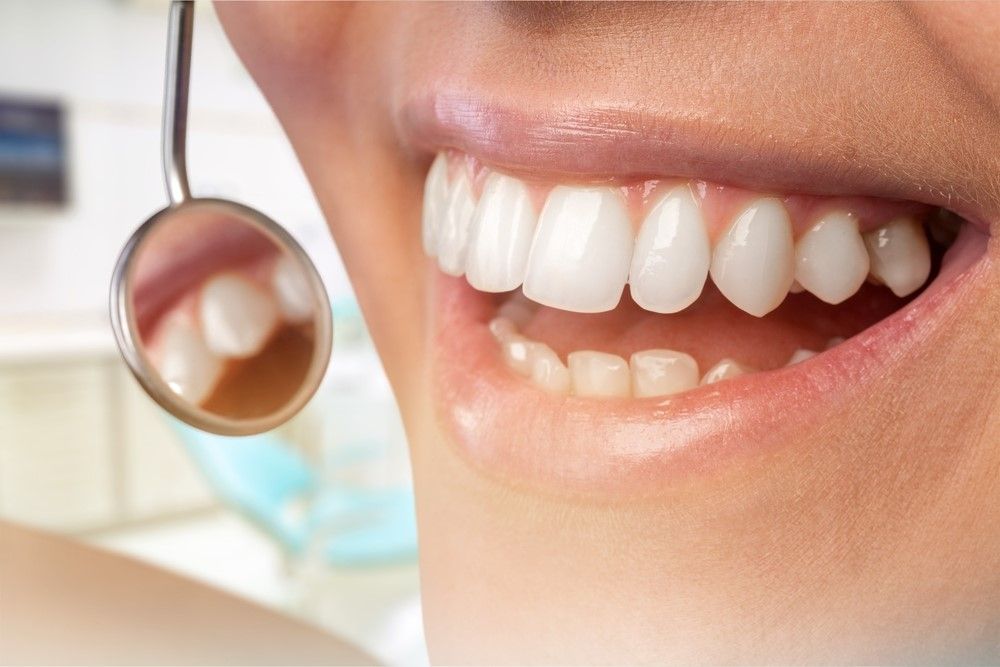
Root Canal
Nothing strikes fear into the heart of dental patients quite like the words ‘root canal treatment’. When the blood or nerve supply of a tooth (often known as the ‘pulp’) becomes damaged through injury, infection, or decay, it can cause the nerve of the tooth to die. Years ago this would have meant that the tooth would have to be removed entirely before the whole area became infected. However, thanks to root canal treatment, it is now possible to save teeth that are at risk from the damaged pulp.
What would happen if I didn’t have root canal treatment?
Infections spread quickly. This is particularly true in our mouths which, by being moist and warm, are a perfect breeding ground for the spread of bacteria. An infection that starts in the pulp can quickly spread through the entire root canal system and if left untreated, could grow to form an abscess. If this happens, bacteria-filled pus will collect under the gums, causing them to swell and become hot and potentially extremely painful. At this point, your dentist will need to prescribe you a course of oral antibiotics and it may be necessary to remove the tooth altogether.
The main goal of root canal treatment is to remove all of the infection from the root canal in order to save the original tooth.
Is root canal treatment really as painful as people say it is?
When you consider that fear of the dentist is an almost universal phenomenon, it isn't surprising that tales of dental treatment are often embellished beyond recognition. In fact, a root canal shouldn't be any more painful than an ordinary filling.
What happens during root canal treatment?
Root canal treatment is quite a complex process and will normally require two to three visits to your dentist.

Restoration Treatment
Restoration treatment is usually recommended by your dentist if you have missing teeth, or if specific parts of your natural teeth are missing and require repair.
Examples of this include tooth structure that is missing due to:
fracture or damage
the deterioration of an existing repair
decay
Types of Restoration Treatment
Restorations come in a variety of different forms and will vary depending on the extent of the restoration required.
Some of the restorations available include the following:
Fillings
Fillings are the simplest and most commonly used variety of dental restoration. They are created from gold, silver amalgam or tooth-colored composite resin and can be put into your tooth in just one visit to your dentist’s office.
Crowns
Crowns are also a very popular variety of restoration that take the form of a tooth-shaped cap and are designed and colored to match your existing teeth as closely as possible. Crowns can sit over an implant to take the place of a missing tooth or to hold a bridge in place, and restore the strength, appearance, shape, and size of your teeth so well that they are virtually imperceptible once in place.
Implants
Dental implants are becoming increasingly popular as they are an extremely robust solution to missing, damaged or unsightly teeth. They are made up of three parts – a titanium screw or post that is inserted into your jaw bone, a crown that acts as a replacement tooth, and an abutment that holds them both together.
Implants are permanent, and once they are in place, you will be able to eat, drink and talk without any impact on your day to day life.

Inlays and Onlays
At your next dental appointment, you may find that your dentist suggests that you receive an inlay or an onlay and it is important that you understand what these procedures include before agreeing to move forward.
Traditional inlays are used instead of fillings to replace a small amount of tooth loss due to decay.
Onlays are similar, but instead of just fitting inside of the tooth, they also cover the chewing surface and are typically used on the back teeth and can cover one or more of the cusps of the tooth.
Inlays
Inlays were initially made of gold and looked similar to fillings. Today, medical advances have allowed for inlays to be made of substances that more closely mirror the appearance and function of the tooth. Inlays may be made of ceramic, porcelain or a type of dental composite.
If you’ve had previous fillings that are failing or appear unsightly, your dentist can replace or repair them with a modern inlay which will improve the function and appearance of the filling.
Onlays
Just like inlays, onlays fit inside of the tooth, but they also cover one or more cusp of the chewing surface. These types of fillings are typically used on the molar teeth and were previously made of the same material as fillings, gold.
New developments have allowed for ceramic or porcelain onlays that more closely match the original tooth color and allow for bonding of the material to the tooth. Recent research suggests that these newer onlays and bonds help to strengthen and improve the tooth.
Knowing When to Use Inlays or Onlays
It’s tough for a patient to understand all the details that make an inlay or onlay the best option to use, but you may want to ask about them if your dentist is considering using a crown.
All of these treatments have specific benefits and drawbacks, so be sure to discuss any questions you have with your dentist before agreeing to a particular treatment.
The Process
Inlays and onlays are similar to crowns, but require less removal or altering of your existing tooth structure which is why they may be preferred over a crown by many patients.
Once the tooth has been adequately prepared, and all the tooth decay and debris have been removed, an impression of the tooth is made. This impression can be made digitally or with a putty-like material that will create a physical cast of your tooth. This impression is then sent to a laboratory where they create a model of your tooth and the final restoration is created in the lab and is designed to perfectly fit your tooth.
If you have opted for a color-treated inlay, it should match your existing tooth color.

Full Mouth Reconstruction
We all know that the first impression is often the lasting impression. Many people are incredibly self-conscious about their smile which can be due to having discolored, missing, or damaged teeth. In order to correct this problem, many patients are opting to visit their dentists to find out more about the process of full mouth reconstruction.
Full mouth reconstruction is the process of making sure that you feel confident with your smile and your overall dental health. The reconstruction process can include many different procedures but will be tailored to your individual needs.
Many of the processes that your dentist may use are designed to replace or repair the upper and lower teeth. This can include implants, partial dentures, bridges, fillings, teeth whitening, or straightening.
Your Dental Health
The single most important factor in maintaining a healthy set of teeth is regular brushing and flossing. Additional care is taken when you visit your dentist for your routine checkups and cleanings. While these processes can help many patients improve or maintain their dental health, it may not be enough for everyone.
When teeth are crooked, damaged, or unevenly spaced, problems can occur. Since abnormal tooth angles that are more difficult to reach, routine dental care may not be enough to adequately clean teeth or damaged surfaces and tooth decay may worsen over time.
Benefits of Full Mouth Reconstruction
While many dentists may opt to fix the problems as they occur, a full mouth reconstruction can offer improved morale and quality of life for many patients. A straight and healthy smile often gives patients improved self-esteem and helps them feel more comfortable in public settings.
A complete full mouth reconstruction doesn’t just fix the problems that are there, but also ensures that your dental health is prioritized. After your procedure is complete, you can feel confident that your mouth is healthy and easier to maintain than before. Many patients also become pain-free which allows them to eat and drink the foods that they once enjoyed.
As teeth decay, bone growth in the jawline can be affected. Full mouth reconstruction and dental implants help to stop bone loss and maintain the existing bone. Implants also help to support the jaw by adding additional strength to your current jawline. Replacing lost teeth has also been shown to help with bone growth and regeneration which is an integral part of the dental implant process.
Full mouth reconstruction doesn’t just offer a replacement as treatment. In the case of damaged teeth, many can be restored with fillings and whitening treatments so that the teeth will match each other. Your dentist will do everything they can to save your existing teeth before they opt for extraction and replacement.
Gum disease is another facet that your dentist may explore by offering help using periodontal or laser therapies. These treatments help to replace and restore gums and the underlying bone.

Dental Crown FAQ
What are dental crowns?
Dental crowns are a very common, popular solution to repair damaged or unsightly teeth. They take the form of a tooth-shaped ‘hat’ that sits over the problem tooth, encasing it entirely right down to the gum line. Crowns are an ideal way to restore the strength, shape, size and overall appearance of any damaged teeth.
What are dental crowns made of?
Crowns can be made from a variety of different materials including metal, porcelain fused to metal and 100% porcelain/ceramic. This means that there is usually at least one type of crown that is suitable for every patient.
Why has my dentist recommended a crown?
Crowns are usually only given to adult patients and may be recommended if:
You have a broken or severely worn down tooth.
You have a cracked tooth that needs to be held together.
You have a severely weak tooth that is at risk of breaking.
You are also having a dental bridge,
as crowns can help hold them in place.You have a tooth that requires a larger filling than is possible (usually due to broken/eroded parts of the tooth).
To cover a dental implant.
You have a discolored tooth.
Your tooth is severely misshapen.
Occasionally a dentist may recommend a crown for infant/first teeth. This is usually because:
The child has a first tooth that is decayed beyond the treatment of a normal filling and a crown is the best option to protect it.
The child is, for whatever reason, unable to complete or withstand proper oral care techniques, putting them at a much higher risk of tooth decay and its associated problems.

Dentures
Dentures are often a difficult topic for people to discuss. It can be embarrassing for many patients to be able to talk with friends and family about their dental health and for these reasons, dentures may also be surrounded in your mind with a negative stigma.
However, dentures are a normal part of many people’s lives, and when you are empowered with the right knowledge, you can feel confident that you are making the best decisions for your dental health.
Dentures tend to increase a person’s quality of life through an improved appearance, reduced or eliminated pain, and the restored ability to eat the foods that they enjoy. While getting dentures can be a huge benefit for many patients, there are some things that may limit the success of dentures.
Here are a couple of things to know.
Gum Shrinkage
When we no longer have teeth that protrude from our gums, the only bone that is left is the actual jawline.
Dentures need to sit along the bony ridges that used to hold the teeth. When tooth decay or tooth loss occurs, the process of resorption often transpires. Resorption is the wasting away or atrophy of bone that leads to a reduction in the actual bone. This shrinkage is the primary reason that dentures don’t fit properly.
Lower Ridge Shapes
Smooth gum ridges are ideal for a proper denture fit. However, those ridges can often degrade, and the shape can change. Completely flat or small v-shaped ridges make it more difficult to achieve a good denture fit. Additionally, extremely bony gums can cause soreness, while fleshy gums can cause excess denture movement.
Palate Shapes
The suction of the upper dentures to your gums can be influenced by the shape of your palate. Square or rounded shapes are more ideal than flat or v-shaped. Some extremes in the palate may also cause additional issues or discomfort.
Potential Lower Denture Problems
The lower dentures are subjected to a lot more movement due to the mobile nature of the jaw and where the tongue, lips, and cheeks tend to dislodge dentures.
In addition, the lower ridge that attaches to the denture is up to four times smaller than the upper ridge allowing less ability for the dentures to adhere and seal to the gums.
In order to successfully wear lower dentures, some patients must change some of their habitual tendencies. Many people place their tongue against or under dental appliances on the lower jaw.
If the tongue is pressed against or under the denture, it can easily dislodge it will need to be replaced in the mouth. Reducing the amount of movement around the lower denture is critical to keeping it in place throughout the day.

Dental Bridges FAQ
There are many different treatments available for badly damaged or decayed teeth, but unfortunately, sometimes a tooth is beyond repair and can leave an unsightly gap in your smile. Gaps between your teeth can seriously knock your confidence, and can even have a negative impact on the functionality of your other teeth and the overall use of your mouth since, over time, your remaining teeth can shift around, causing misalignment as well as a range of other associated dental problems.
Dental bridges fill the gap where the missing tooth would have been by using a false tooth, which looks and feels just like the real thing.
The false tooth also holds the remaining teeth either side in place so that they don’t shift into that space.
How do dental bridges work?
Dental bridges are comprised of two or more crowns for the teeth on either side of the gap which act as anchors for the false tooth/teeth that will fill the gap.
Once your dental bridge is in place, it should be virtually imperceptible.
The anchoring teeth are often referred to as abutment teeth and the false teeth are often called pontics.
What are the false teeth made from? Will they look odd?
The pontics can be made from a number of different materials including metal alloys, gold or porcelain, depending on what cosmetic finish you want to achieve. If you choose porcelain, they can be color-matched to your existing teeth so that they look completely natural.
What are the benefits of dental bridges?
There are a number of benefits of having a dental bridge. They can:
Prevent your remaining teeth from shifting position.
Help you bite and/or chew properly.
Correct your bite.
Properly align your jaw.
Maintain the shape of your face.
Give you a great smile.

Sealants
If you’ve recently had a dental procedure, you may have received a sealant treatment. It is a quick and easy procedure that many patients don’t know much about. Sealants are thin plastic coatings that are painted onto the surface of the tooth that help to reduce tooth decay and protect the underlying tooth.
Once sealants are placed, they quickly bond with the surface of the tooth. This plastic coating helps to protect the enamel that covers the tooth on the chewing and grinding surfaces. This process is usually done on the flatter back teeth, such as the molars and premolars, to help protect them from a buildup of bacteria between the cusps of the teeth.
While brushing and flossing are effective at removing most food and sugar particles, the rear teeth contain many places that allow for buildup. Sealants help to protect these vulnerable points by “sealing” the tooth from allowing this buildup to ever touch our enamel.
Who Needs Sealants?
While sealants are rather easy to place, they aren’t for every patient. Typically, dentists will place sealants on children and teenagers when they first get their premolars and molars. This helps to protect their teeth through a person’s more cavity-prone years. However, dentists may also put sealants onto an adult’s mouths when they have tooth decay or fillings in their molars.
In some cases, a dentist may also place sealants onto a patient’s baby teeth in order to help keep those teeth healthy and aid in the proper development of their adult teeth. Baby teeth are important to hold spacing for subsequent adult teeth, and early baby tooth loss may require additional spacing or alignment when the adult teeth erupt.
How Sealants are Placed
The process of placing sealants is relatively fast and completely pain-free. However, proper sealant placement requires a few steps to be followed in order to ensure that they properly adhere to the teeth and don’t seal in any bacteria underneath.
Thorough cleaning – The teeth that are going to be sealed should first be thoroughly cleaned. This will ensure that there no cavity-causing bacteria will be allowed underneath the sealant as well as provides a good surface for the sealant to adhere to.
Dry the tooth – If the tooth is wet, it may not allow the sealant to adhere to the tooth properly. Each tooth will be dried, and a piece of cotton or other material will be placed around the tooth to keep it moisture free.
Roughing the surface – The smooth surface of your tooth doesn’t allow the sealant a good surface to adhere to, so an acid solution is placed on the tooth which will give your tooth a rougher texture and more surface area to allow the sealant to cling to the tooth properly.
Rinse and dry – The tooth is then rinsed and dried to clear the acid solution.
Paint the tooth – The sealant is then brushed onto the tooth enamel which then bonds to the tooth. Sometimes a special light will be used to cure the sealant and further harden the protective coating.

Bone Grafting
We often think of our bones as rigid and unchanging materials in our bodies, but the truth is that our bones are constantly undergoing a process called remodeling. Remodeling is where old bone is replaced by new stronger bone and new bone cells are deposited while the old bone cells are recycled. Sometimes, this process can result in the damaging or weakening of the bones, especially when it comes to the bones that hold our teeth in place. As we enter adulthood or encounter sickness and disease, tooth loss can also be accompanied by the process of resorption, which is when the surrounding bone starts to be resorbed back into the body. As we lose more teeth and bone structure surrounding the teeth, facial features may begin to sag. However, modern medicine has been able to help restore this bone loss through bone grafting which is a procedure that builds bone and can restore tooth strength and appearance. While bone grafting may sound like a significant surgical procedure, it can be performed in most dentist’s offices. The procedure itself involves making a small incision in the gums and then adding grafting material through the incision to the bones. The grafting material is composed of minerals that trigger your body to grow new bone which will, over time, cause your body to deposit and build bone by itself. The grafting material comes in a variety of different forms including as a powder, granules, or a gel that can be inserted through a syringe. This material can come from an animal, a human, or even yourself that is processed by a laboratory to ensure that it is clean and sterile. Once the bone graft has been placed, it is usually then covered with a thin membrane that acts as a framework for the new bone to be deposited upon.
Bone Graft Uses
Bone grafts are used in a variety of dental applications including:
Teeth Saving – Periodontal disease accounts for a large portion of lost teeth in dental patients. As the underlying bone weakens and teeth become loose, your dentist may suggest a bone graft to try to save and strengthen the teeth.
After Tooth Extraction – Once an adult tooth is removed, it leaves an empty socket. Bone grafts can help to fill in this space and strengthen the jaw. Bone grafts also help to reduce the possibility of the body beginning to resorb the surrounding bone.
Dental Implants – When a dental implant is placed, a small titanium post is placed into the jawbone. If the underlying bone is already weak, then it may make this placement difficult. A bone graft can help to strengthen the jawbone and allow for secure placement of the post and the associated implant.

Fluoride Treatment
Fluoride is a naturally occurring mineral that helps to strengthen teeth and protect them from cavities caused by dental decay. Dental decay happens when the sugars in the food and drink we consume interact with the bacteria in the mouth and produce a sticky film on the teeth called plaque and plaque acids. If plaque and these acids are not removed from our teeth promptly, they can start to cause damage. Plaque acids will eventually erode the outermost layer of the tooth, exposing the softer, inner sections which are more sensitive and can cause pain. If decay is left untreated, it can eventually penetrate the pulp which is the innermost part of the tooth where the roots are located. If the roots become affected by decay, they will be unable to deliver blood and nutrients to the tooth that are needed to keep it healthy which can result in the tooth dying and falling out or requiring extraction.
Studies have shown that fluoride treatments are highly effective at providing additional protection against tooth decay when it is applied at least twice a year. For this reason, many dentists are now offering fluoride treatments alongside your regular, six-month dental check-ups. It is especially recommended for those patients who are at higher risk of developing cavities.
Am I at increased risk of cavities?
There are various groups of people who are more likely to suffer from dental cavities that would significantly benefit from fluoride treatment. These include people:
with poor oral hygiene
who use drugs or drink alcohol to excess
with a particularly poor diet
who have weakened dental enamel
who suffer from dry mouth
who haven’t seen a dentist in a long time

Deep Cleaning
Many patients may have heard the term deep cleaning and believe that to be the work that their hygienist performs every six months. However, deep cleanings are not the same as the routine cleanings that are being performed. Deep cleanings are generally conducted after patients have missed their regular cleanings for a long period of time and are used in order to correct any periodontal or gum disease.
When You Need Deep Cleaning
When you go to the dentist, your hygienist will use a probe in order to assess how much bacteria or buildup there is on or around the teeth. The depth of the gum tissue that lies between the teeth is called pocketing if there are more than 5 millimeters between the gums and teeth. This can be a concern because pocketing provides areas that harbor bacteria which can harm your teeth and deteriorate the enamel.
In the case that your hygienist measures pockets that are 5 millimeters or greater, it is likely that your dentist will suggest that you receive a deep cleaning which is typically arranged as a separate appointment.
The Process
Deep cleaning is a straightforward service that you will schedule with your hygienist. The appointment time will vary depending on the level of work that needs to be performed. Deep cleaning involves two processes — scaling and root planing.
Scaling is the process of removing plaque and tartar from the surface of the tooth and from within the pockets between your teeth and gums. Your hygienist will use a small tool or an electronic ultrasonic instrument to scrape away any buildup on the tooth and remove it with a rinse or flossing.
After the scaling has been completed, your hygienist will then perform the root planing which involves the same tool types as scaling but focuses on the root of the tooth. By ensuring that the root is clean and free of debris or buildup, it allows the gums to naturally heal back over the roots and eliminate or reduce the pocket size.
Deep cleaning typically involves at least two appointments, but your dental office may schedule follow-up appointments to ensure that your mouth is healing and the pocket size is getting smaller or if any additional work is required.
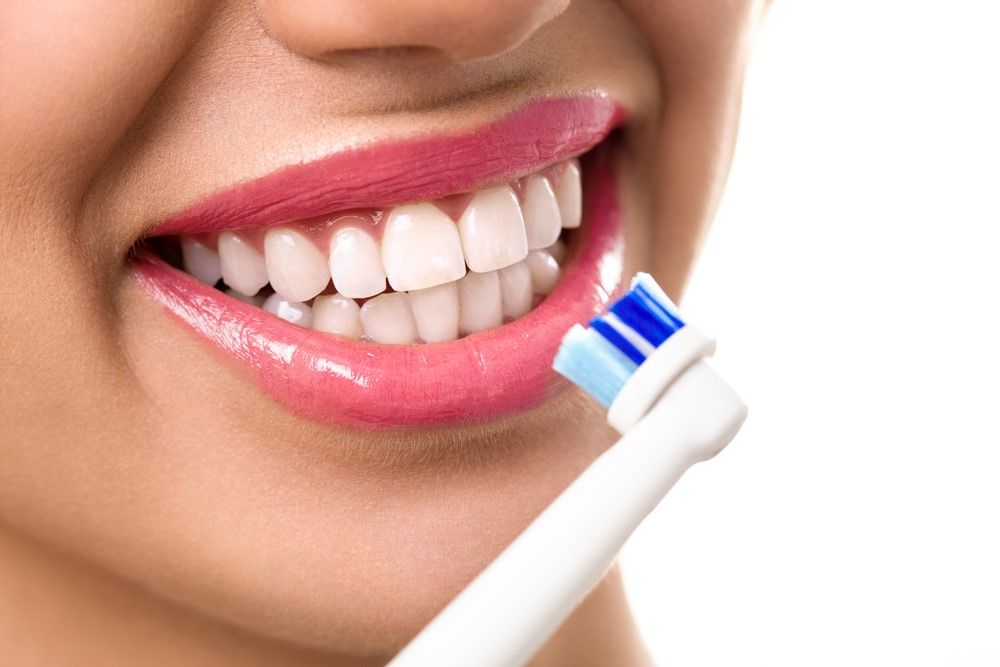
Oral Care Recommendations
Finding basic information on what you should be doing for your teeth can be difficult since advertisers have saturated the market trying to prove why their product is the best or only option for your teeth. However, dental care doesn’t have to be that difficult. In order to help keep you on the right track for your dental health and away from chasing the newest and unproven fads, we’ve compiled a list of tried and true methods for your home oral care.
Brush Your Teeth
This is probably the single most common piece of advice. For every age and condition, dentists recommend that you brush your teeth twice a day. For anybody that understands not to swallow toothpaste, teeth should be brushed with a toothpaste that includes fluoride. You should brush for two minutes each time which you can keep track of by using a simple kitchen timer or an electric toothbrush since many have automatic timers that run for two minutes.
Use Fluoride
Many municipal water supplies have fluoride added as a treatment to their water and while this certainly helps to protect your teeth, you should also use fluoride toothpaste. If you believe that you still aren’t getting enough protection, you can talk to your dentist about prescription fluoride options or get fluoride treatments when you visit your dentist for your regularly scheduled cleanings and checkups.
Clean Between the Teeth
While flossing is the most common type of interdental cleaning method, you can also use a variety of products that are out on the market, such as a water pick. The goal of cleaning between the teeth is to be able to remove food debris and sugars from the spaces that brushing can’t get to.
Eat Healthy
Being mindful of your diet helps your general health in many ways beyond your teeth. However, dentists see a correlation between your diet and your dental health. You should try to limit your intake of sugars and sugary drinks as sugars attract bacteria that can cause damage and weaken the enamel of your teeth. When this enamel is worn down, teeth become more susceptible to cavities.
Get Your Checkups
Dentists recommend that you see them twice a year which allows them to regularly monitor your teeth and catch any issues before they become significant. Regular visits to your dentist also help to remove plaque and tartar buildup before it becomes a major issue.
For people who have concerns or fears of the dentist, there are other options out there to help make your experience more pleasant. Talk to your dentist and be open about your concerns.
Use Mouthwash
While this isn’t necessary for every patient, it can help people who have an increased risk of gum disease. Look for mouthwash and even toothpaste that have antimicrobial properties. Utilizing products that help to kill bacteria can help reduce the damage to the enamel of your teeth and keep you cavity-free.
Additionally, if you have an increased risk of caries, there are many types of mouthwash that also contain fluoride. These treatments give you one more weapon in your arsenal to fight against poor dental health.

Tooth Decay
Tooth decay is the single most common dental problem affecting Americans today. It is a leading cause of dental pain and the most noted reason for patients to visit their dentist for advice and support. You may hear your dentist use the terms ‘dental caries’ or ‘dental cavities’, but both of these mean that you have at least one tooth being affected by tooth decay.
What is tooth decay?
Tooth decay is the destruction of the outermost layer of your teeth, known as the enamel, by a substance known as plaque acid. Plaque acids are created when bacteria within the plaque break down sugars in your mouth that are there as a result of eating and drinking. Enamel is usually very resilient, but if it is persistently attacked by plaque acids, it softens and eventually forms holes. These holes are known as cavities or caries and must be treated promptly after they form. Failure to do so can cause the decay to spread to surrounding teeth as well as penetrate even deeper into the original tooth, causing sensitivity and discomfort.
Eventually, if decay is allowed to reach the root of the tooth then you will almost certainly experience a toothache, especially when you eat or drink. The root, which carries to the tooth healthy blood vessels and nutrients, can become infected and the tooth will die.
Abscess formation is the final stage of tooth decay and by far the most painful. Once the bacteria pass into the root, it can put the conjoining bones at risk of infection. This increases the likelihood of tooth loss and other diseases as the infection passes into the bloodstream and around your body.
Causes of tooth decay
There are a variety of different things that contribute to the development of tooth decay. However, there is ultimately one key factor that determines whether someone is more likely to suffer from tooth decay, and that is their commitment to oral hygiene.
Brushing and flossing your teeth is the single, most important thing that you can do protect your teeth from decay, and failure to do this properly on a daily basis will mean that the plaque acids are not removed before they cause damage to your teeth. Flossing and using fluoride mouthwash also helps to remove bacteria and keep your teeth in great condition.

How to treat gum disease
Gum disease is an exceedingly common oral health problem and is estimated to affect more than half of the U.S. population. Unfortunately, since it is very easy to ignore in the earliest stages of the condition, it is often fairly advanced by the time it is diagnosed which means that irreversible damage to your oral health may have already occurred.
While gum disease may be unpleasant and have significant consequences for your teeth and general health, it can be treated, and even prevented entirely.
What is gum disease?
Gum disease is an inflammatory oral condition that is caused by the invasion of bacteria-laden plaque into the soft tissue of the gums. When this happens, the gums become sore and swollen and may start to bleed when you brush your teeth which at this stage, it is often known as gingivitis. Since the symptoms are usually fairly mild, they can be easily overlooked and ignored. However, if treatment isn’t sought soon enough, the condition can progress and become much more severe.
Symptoms of gum disease
There are many symptoms of gum disease that tend to worsen as the condition worsens. Some signs to look out for include:
Red, swollen and tender gums
Gums that bleed when you brush your teeth, floss or eat particularly hard food
Teeth that look elongated as a result of gum tissue receding
Pus between your gums and teeth
Persistently bad breath
Sores in your mouth
Teeth that seem loose
A change in the way that your teeth come together or in the way that your partial denture fits
If you are experiencing any of these symptoms, it is important to schedule an appointment with your dentist so that your teeth and gum health can be professionally assessed.

Dental Implants FAQ
The newest method in dentistry used to replace missing or extracted teeth is a procedure called dental implants. Dental implants consist of three key components – a screw-like piece of metal called an anchor is first inserted into the jawbone, then a crown that acts as a replacement tooth is placed on top of the anchor, and an abutment is used to secure the two together.
How does the anchor stay in place?
The anchor is made of a very tough and durable material called titanium. Once the implant is inserted into your jaw, a process called osseointegration takes place where the bone that surrounds the implant begins to fuse to the anchor which strengthens it even further. It is not until this has happened that the replacement tooth will be fitted, but once in place, your new implant will be as secure as a regular tooth.
Will my implant be noticeable?
One of the biggest reasons that people choose implants is their subtlety. The only visible part of your implant is the replacement tooth which will be color-matched so that it is the same as your existing teeth. And since it is a permanent fixture, you can eat and drink as normal as there is no need for unsightly denture removal which means that no one needs to know you have a dental implant unless you tell them.
How successful is the procedure?
Dental implants have the highest success rate of any implanted surgical device at around 98%. However, a robust oral hygiene routine is crucial to ensuring their results for the long term.

Wisdom Teeth / Oral Surgery
Wisdom teeth are usually the very last teeth to erupt and while they generally arrive between the ages of 17 and 25, many people still have problems with them pushing through years later. Although adults can have up to 32 teeth, we rarely manage to fit more than 28 in our mouths at any one time. So if your mouth is already full when your wisdom teeth start coming through, you could be in for a bit of trouble.
Wisdom teeth are situated at the very back of the mouth and if you have enough space for them to come through normally, then you shouldn’t experience any problems other than mild discomfort when they actually cut through. However, if there is limited space for them, they could come through at an unnatural angle, which could damage surrounding teeth and cause you pain.
When this happens, your dentist will refer to it as an ‘impacted wisdom tooth’ and will likely recommend surgical intervention. Your dentist will most likely also take some x-rays of your wisdom teeth in order to assess them as they are coming through to help decide if the intervention will be necessary.
Wisdom teeth problems
Wisdom teeth are quite large and therefore cutting them may be a painful experience, especially since they don’t necessarily all come at the same time. Wisdom teeth are made up of four sections and many people find that they erupt one corner at a time. This is called pericoronitis. When the wisdom tooth comes through in this way, the gum tissue surrounding the tooth often gets swollen and sore, causing mild to moderate pain.
The gum edges are also susceptible to infection as tiny particles of food and bacteria can collect there, even when the area is thoroughly cleaned several times a day. Roundhead toothbrushes and antiseptic mouthwash can help prevent this from happening, but if your wisdom tooth does get infected, you will be prescribed a course of antibiotics to completely clear any infection.
If you suffer from recurrent wisdom tooth infections, or your wisdom teeth are proving particularly difficult to cut through, your dentist may recommend surgical intervention to remove the wisdom teeth altogether.

TMJ
TMJ stands for temporomandibular joint. This joint acts as a sliding hinge that connects your jaw to your skull.
While everybody has a temporomandibular joint, when somebody says that they have TMJ, they are generally referring to a disorder of that joint commonly referred to as “lockjaw.”
A disorder in the TMJ is often associated with pain or discomfort. It may be difficult for your doctor or dentist to identify the exact cause of your pain, but there are several potential culprits:
Arthritis
Genetics
Jaw injury
Teeth grinding or clenching
Fortunately, most cases of TMJ can be treated without invasive procedures or operations and is often temporary.
Symptoms
While TMJ is associated with several symptoms, patients may experience just a few as no case is typical.
Jaw pain or tenderness
Pain in one or both temporomandibular joints
Aching facial pain
Locking of the joint that makes it difficult to open or
close your mouthAching pain near the ear
Difficulty chewing
Popping or grating when chewing or moving your jaw
When You Need a Dentist
While TMJ is generally temporary and there are many possible solutions, you should consider seeing your dentist if your pain is persistent or if you are unable to open or close your jaw completely. Your dentist will be knowledgable about the potential causes and possible treatments of TMJ and will help to guide you on the right path to relief.
TMJ Causes
Your temporomandibular joint is a sliding hinge between your jaw and skull. In the middle of that joint is a small disk that helps to absorb shocks to the jaw.
TMJ can develop into a disorder if:
The disk is damaged or deteriorates
The disk moves out of alignment
The joint is damaged by injury or arthritis
While these causes are fairly straightforward, there are several other options that will need to be explored by a medical professional in order to ensure that you receive the appropriate care and treatment.

Sleep Apnea
We often think of sleep apnea as an annoying condition that doesn’t allow people to get a full night’s rest. However, sleep apnea can be a very dangerous condition if it is left untreated.
The traditional treatment has been to use a loud, bulky machine that is strapped to your face while you sleep which for some people can often seem just as scary as the diagnosis.
Fortunately, there are other options that may be able to help you with your sleep apnea and get quality sleep once again.
What is sleep apnea?
Sleep apnea is a medical condition that causes people to stop breathing during sleep. The periods where there is no breathing can vary in length and frequency.
There are two types of sleep apnea:
Obstructive sleep apnea – This condition is caused by something that completely or partially blocks your airway. Obstructive sleep apnea is the most common form of sleep apnea.
Central sleep apnea – This is caused by the failure of the brain to send the proper signals to your respiratory system to breathe.
What are the Causes?
Obstructive sleep apnea is generally the result of soft tissues collapsing and blocking the airway which is usually caused by muscle relaxation, but can be exacerbated by individuals with excess weight.
Airways can also become obstructed due to swelling, misalignment of the mouth or upper airway, alcohol use, or allergies.
What are the Effects?
When the airway becomes blocked, it causes people to wake up for at least enough time to start breathing again. These periods are often not remembered by the patient in the morning, but they have serious effects on your ability to rest.
In addition to a lack of proper rest, untreated sleep apnea can lead to:
Heart attacks
Stroke
High blood pressure
Acid reflux
Heart disease
Diabetes
Erectile dysfunction
Diagnosis
Fortunately, the diagnosis of sleep apnea is a relatively straightforward process. Some dental offices offer an in-office test to study the collapsibility of the airway while you are awake.
Depending on the results of that test, you may be scheduled to conduct a sleep study. Sleep studies are often conducted at home and require you to wear a small medical device that tracks your rest and breathing. The following day, you return the device to your medical office to interpret the results.
If these tests indicate that you have sleep apnea, your medical provider will discuss your treatment options with you to find the one that may be right for you.
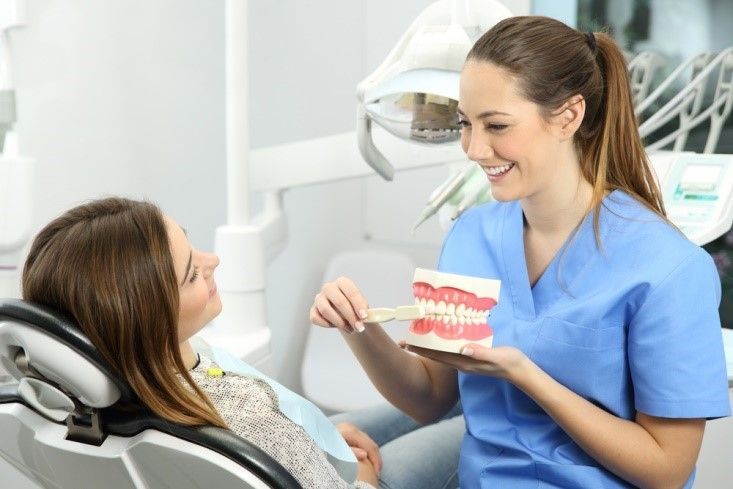
Sensitive Teeth
Around 40 million Americans are currently experiencing some type of tooth sensitivity, and most of us will have at least one episode of sensitive teeth during our lifetime.
Sensitive teeth can cause significant problems, often triggering dull or sharp pain when eating, drinking or brushing your teeth. You may even find that sucking cold air into your mouth makes your teeth hurt. Sometimes this pain dissipates as quickly as it starts, but sometimes it can last for several hours.
When tooth sensitivity occurs, it is important to check with your dentist to make sure that there isn’t an underlying problem causing your pain. Decay and damage to your teeth can trigger discomfort that is very similar in nature to tooth sensitivity and need to be addressed fairly quickly in order to prevent further complications from occurring.
What causes sensitive teeth?
There are a variety of different things that can cause sensitive teeth. In addition to dental decay that has been left untreated, some of the most reasons
common include:
Worn tooth enamel, caused by aggressive brushing and using a hard-bristled toothbrush.
Tooth erosion as a result of high levels of consumption of acidic foods and drinks.
Leaking fillings and cracks in your teeth that expose the softer and more sensitive inner layers.
Gum recession that has left some of the root of your tooth exposed.
- Grinding your teeth at night.
- In some instances, the sensitivity might also arise as a side effect of a dental treatment you may have had recently, particularly any teeth whitening, dental crowns, or cavity fillings.
Treatment for sensitive teeth
Fortunately, you don’t have to live with the discomfort of sensitive teeth forever. The first thing you should do is visit your dentist to make sure that there isn’t a more sinister reason for your tooth pain. If there is no obvious underlying cause, there are a few things that you can do to help alleviate your tooth sensitivity.
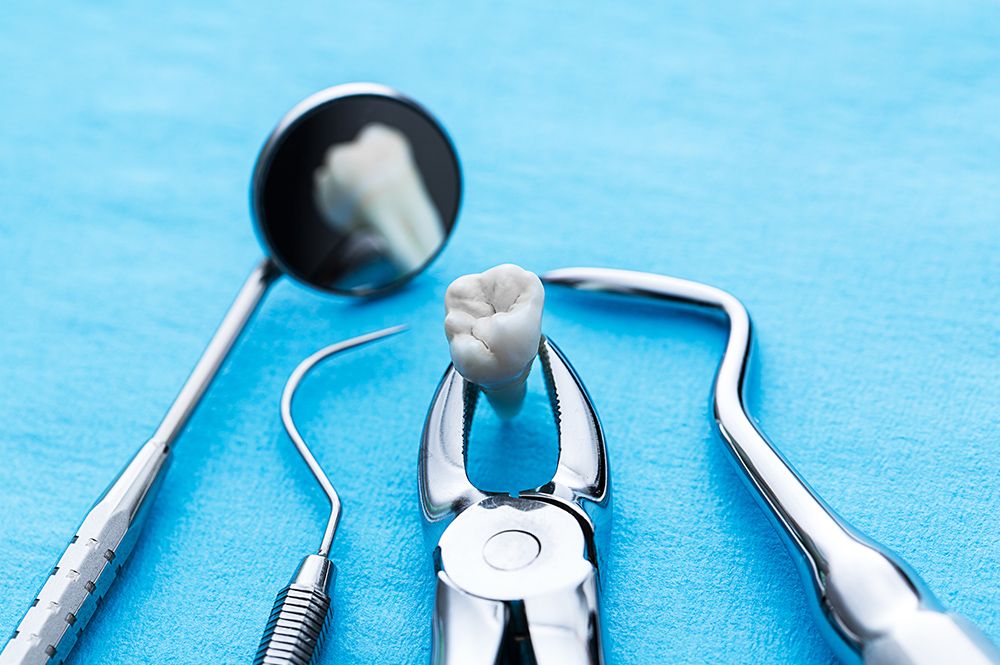
Tooth Extractions
While your dentist will always do everything possible to maintain your natural teeth, there is no getting away from the fact that sometimes, issues occur that mean that the best way to preserve your oral health and the rest of your smile is to remove problem teeth. Fortunately, you won’t be alone. Tooth loss is very common, and by the age of 50, most Americans will have lost an average of 12 permanent teeth. And thanks to innovations in dental technology, it is now easier than ever to replace missing teeth with very comfortable and natural-looking alternatives.
Having a tooth removed can be a daunting prospect, and it can help to know what to expect. With this is mind, here is what you need to know about tooth extractions.
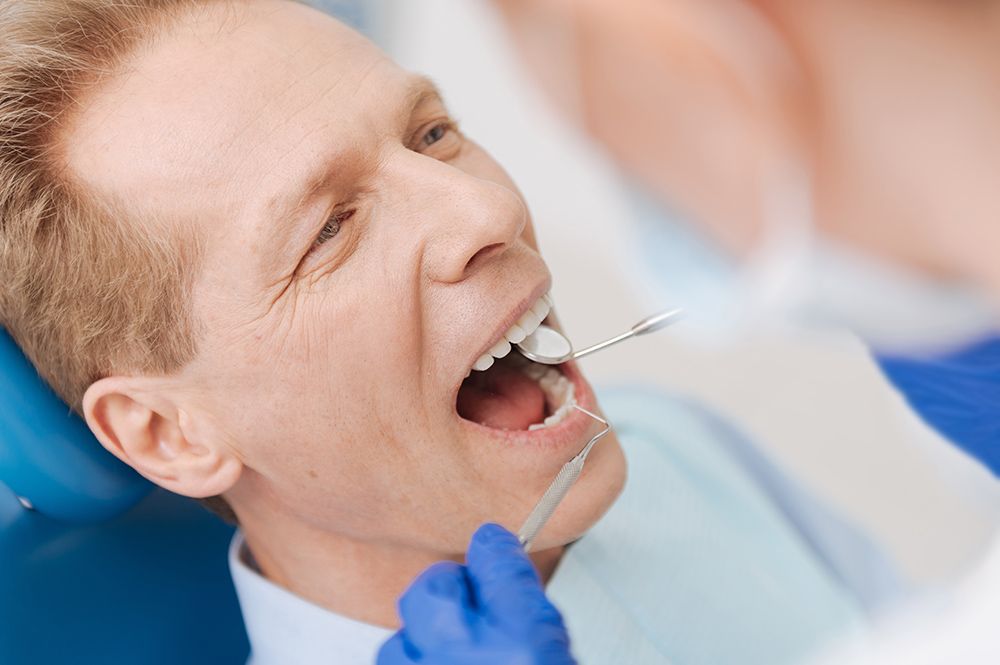
Oral Cancer Screenings
Cancer can affect any area of the body, including the mouth. Research estimates that around 49,000 Americans are diagnosed with oral cancer every year. Of these, just 57% will survive for at least five years following their diagnosis. These are shocking statistics, but the relatively poor outcome of patients is primarily a result of late diagnosis.
Like all cancers, patients have a much better chance at recovering from oral cancer if it is diagnosed early on. However, in many cases, the signs of the disease are not spotted until they have advanced – often after it has metastasized to other areas of the body, such as the lymph nodes. Once any cancer has spread, it is much harder to treat it successfully.
Since the symptoms of oral cancer can be difficult to spot on yourself, visiting your dentist for regular oral cancer screenings is strongly recommended. In fact, many dentists now incorporate oral cancer screening into every routine check-up appointment.
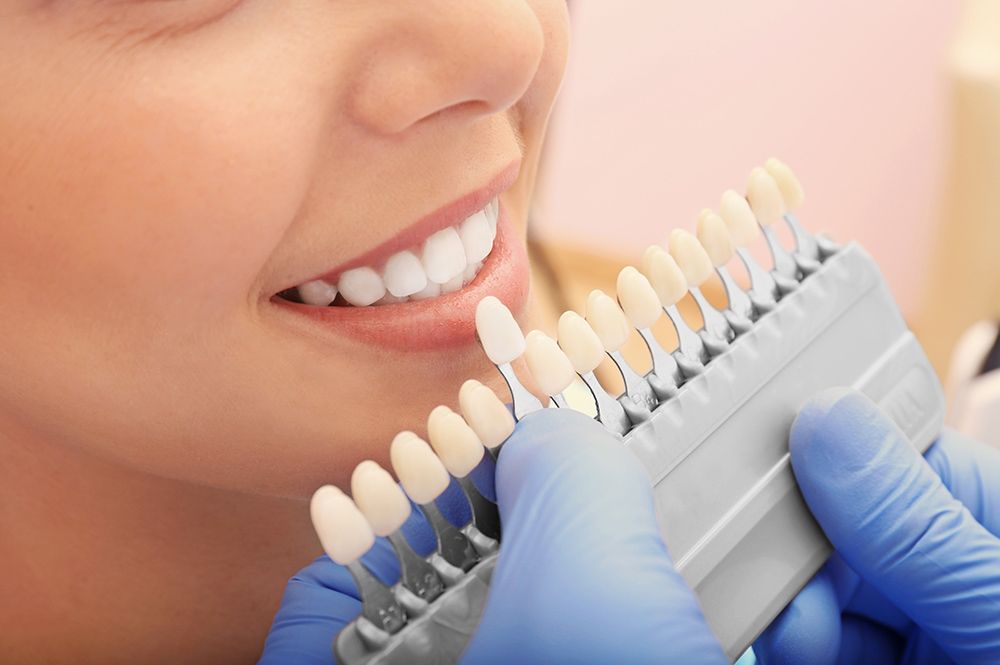
Tooth-Colored Fillings
Fillings are one of the most common dental restorations, used to treat small areas of decay in the teeth. When you need a filling, the decay is drilled out and cleaned so that there is no remaining bacteria, before the hole is filled using a filling.
Fillings can be made from several different materials. In the past, nearly all patients had fillings made from metal amalgam. This dark grey material contains a mix of metals and while robust, is very obvious in appearance. This means that it is clear when someone has an amalgam filling, and this has the potential to affect their confidence in their appearance. Fortunately, there is another option – tooth-colored fillings.
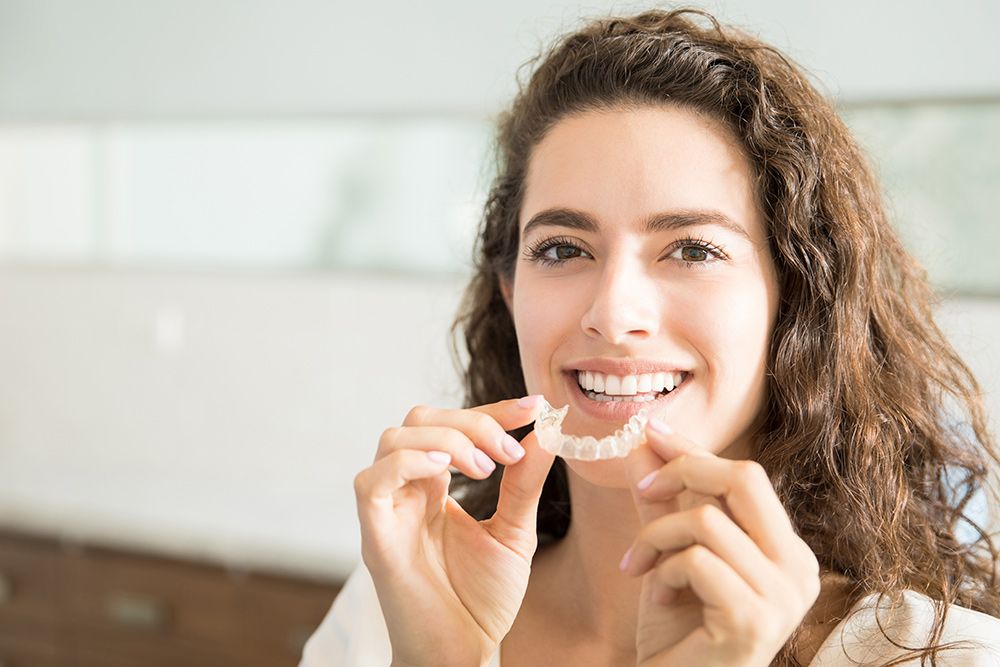
Invisalign
Most people are unhappy with at least one aspect of their smile and while there are a variety of issues that can create this unhappiness, the most common complaint is crooked or gapped teeth. If either of these reasons is why you aren’t completely happy with your smile, then it’s time to do something about it! Before assuming it is too costly or requires a complicated treatment plan, you’ll want to check out Invisalign. This teeth-straightening system is much simpler than traditional wire braces and nobody will even know you’re wearing them!
How Invisalign Works
Invisalign consists of a series of clear aligners that correct teeth crookedness over a period of time. Each aligner is customized according to the patient’s needs and comfortably fits each and every time. Impressions for Invisalign fortunately no longer require uncomfortable casting, but instead, a 3-D scan is used in order to obtain tooth imaging and is accomplished in a matter of minutes! The imaging is then used to create the aligners and show the patient exactly what they can expect for results.
From there, the images will be used to create the aligners that will be mailed to the patient’s home as soon as they are ready. The number of aligners will depend on the severity of the issue, but most people complete the process in a year.
Patients should expect to wear their Invisalign aligners for the majority of the time. It is recommended only to take them out when brushing and eating. As your teeth start to align, your dentist may adjust how many hours per day you should wear your aligner, but to ensure the quickest and best results, you should wear the aligner for the suggested amount of time.
Is Invisalign Right for you?
Invisalign is a great system for straightening teeth and closing gaps but is not the right choice for everybody as there are a few more severe orthodontic issues that Invisalign can’t correct. It is also important to remember that this system requires a bit of self-care, so if you are not committed to wearing the trays as recommended, then this system will likely not work for you. A skilled dentist will be able to identify if your current concerns can be corrected by Invisalign.

Lumineers
Lumineers are an effective way to transform the appearance of your smile. While they are similar to porcelain veneers and can be used to address many of the same issues, they also have some differences.
The main way that Lumineers differ from conventional porcelain veneers is in their thickness. Lumineers are significantly thinner at approximately 0.2mm which affords patients several benefits. Firstly, their thinner appearance means that they more closely resemble the translucency of natural dental enamel, making them extremely discreet. Secondly, and for many people most importantly, their thinness means that in most instances, there is little to no preparatory work needed. This allows them to be fitted more quickly, without the need for local anesthetic, filing, and any associated inconvenience.
Won’t the thin nature of Lumineers compromise their durability?
Some may think that the ultra-thin nature of Lumineers means that the strength, durability, and longevity may be compromised, but this is far from the truth. Studies have shown that proper at-home care and regular dental check-ups can help Lumineers to last for several decades or longer.
What cosmetic issues can Lumineers resolve?
Lumineers are versatile and can be used to resolve a variety of different cosmetic dental issues including:
Correcting teeth that are slightly crooked
Covering teeth that are discolored or stained
Closing small gaps between teeth that look unsightly or that cause food and bacteria to become trapped
Create greater uniformity across the size and thickness of all of your teeth
Covering cracks, chips, and other superficial damage
If you aren’t sure if your cosmetic issue can be resolved using Lumineers, your dentist will be happy to advise you.

Cosmetic Bonding
There are many different types of cosmetic dentistry treatments now available with cosmetic bonding being one of the simplest yet most effective. The process of cosmetic bonding involves the application of a special resin over the top of the teeth, which is then shaped and molded to cover any imperfections and improve the overall appearance of the patient’s teeth. The effect of cosmetic bonding creates a smile that looks healthier, more even and more attractive than before.
What cosmetic issues can bonding be used to address?
Cosmetic bonding can be used to improve various aspects of patient smiles including:
- Covering cracks, chips, and other superficial damage
- Adding thickness to thin teeth or teeth that are set-back from the rest of the arch
- Closing small gaps between the teeth
- Adding height to short or eroded teeth
- Covering stains or discoloration and enhancing the overall color of the teeth
If you are unsure if cosmetic bonding is the best solution to improve your smile, your dental team would be happy to offer their experienced opinion.
How is cosmetic bonding performed?
The procedure for cosmetic bonding is non-invasive, straightforward, and can be completed in just one appointment, making it extremely convenient for busy patients. First, the resin is created in the shade needed to match your existing teeth or improve the color of your entire smile. It is then applied, one tooth at a time, and molded and shaped as needed depending on the type of imperfection you are trying to correct. Although this may sound easy, it is most definitely an art form and you need to ensure that you have an experienced dentist who knows how to create the improvements you desire in such a way that they look natural. Once the resin has been applied and your dentist is happy with the way that it looks, it is hardened using a special curing light. The process is finished by polishing the teeth so that they closely resemble the color and translucency of natural teeth. There is no downtime with this procedure, so you will be able to go back to your usual activities immediately after your appointment.
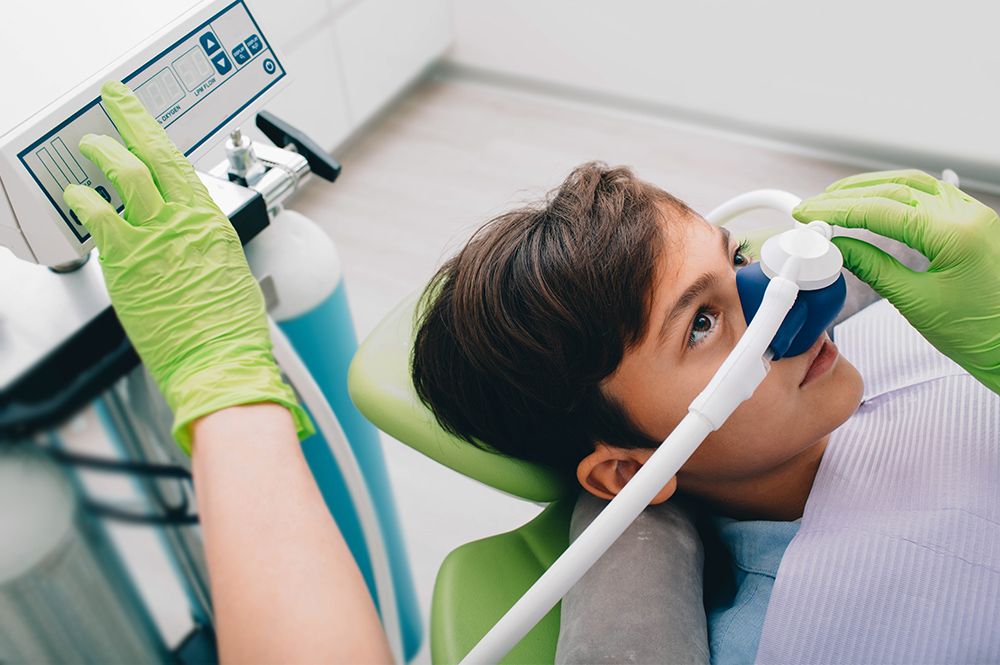
Sedation Dentistry
Does the thought of visiting the dentist fill you with dread? If so, you could be one of 15% of the U.S. population with anxiety or fear of visiting the dentist. Being scared of going to the dentist is a well-known cliché, but for those people who suffer from it, it can be a debilitating problem that prevents them from getting the support with their oral health that they need to enjoy an attractive smile and good general health and wellbeing.
If this sounds like you, then chances are that you are already concerned about the condition of your teeth and oral health. How long has it been since you last visited your dentist? A year? Two years? Maybe more? During that time, you may have started to develop issues such as bad breath, toothache, discolored teeth or receding gums. You may even have lost a tooth or two. Many people who live with fear of the dentist would rather avoid eating certain foods, take pain medication and suffer the consequences than see their dentist. But many of these people don’t know that it is now far easier to get the oral health support that they need without stress and anxiety, thanks to sedation dentistry.
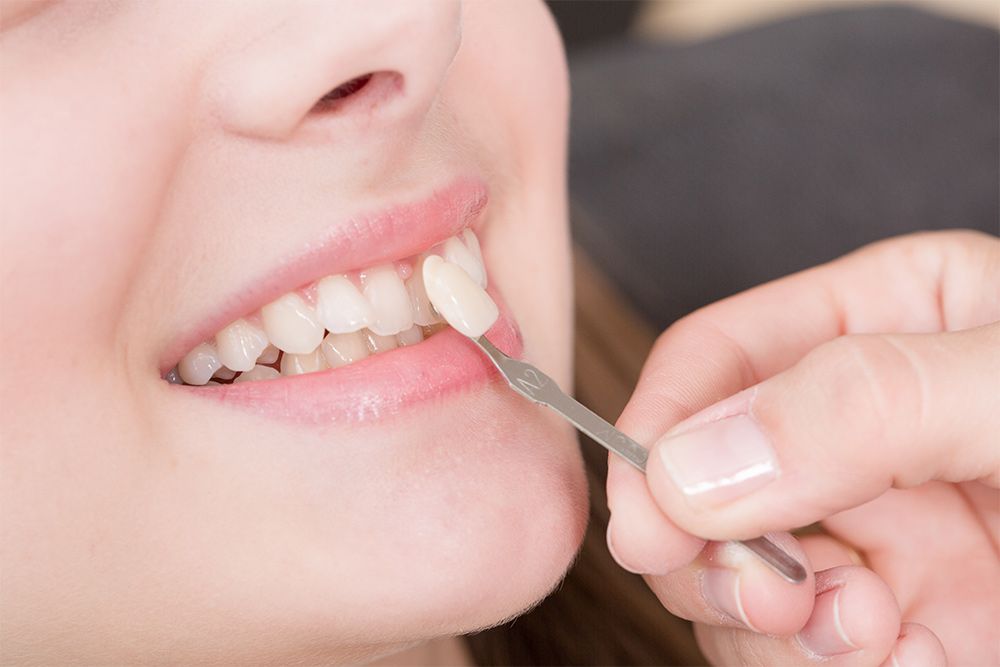
Porcelain Veneers
Porcelain veneers are arguably one of the most popular cosmetic dentistry solutions currently available. These thin, fingernail-like covers are applied to the outer enamel of the teeth where they work to cover any cosmetic imperfections and improve the overall appearance of the teeth. In doing so, porcelain veneers can transform any smile and give patients greater confidence to share their smiles with the world.
Porcelain veneers are unique to each patient and can be applied individually to address an issue with a single tooth, or in sets so that you can improve virtually any part of your smile. They can also be created in a variety of different shades, making it possible to match individual veneers to your natural teeth so that they look extremely discreet or, alternatively, so they can change the color of your entire smile.
What cosmetic issues can be corrected using porcelain veneers?
Porcelain veneers have been shown to be extremely effective and successful in treating a variety of different cosmetic dentistry issues including:
Covering chips, cracks and other minor imperfections
Closing small gaps between the teeth
Adding thickness to teeth that are set back from the rest of the arch
Adding height to teeth that are undersized or have been eroded
Covering stains and discoloration
If you are unsure whether your cosmetic issues can be corrected using porcelain veneers, your dentist will be able to advise you.
What is the process to receive porcelain veneers?
Porcelain veneers are applied in a two-step process that involves two visits to your dentist’s office. During the first visit, impressions of your teeth will be taken and the shade that your porcelain veneers will be made in will be determined. This enables your veneers to be created in the perfect shape, size, and color to enhance the appearance of your teeth. When they are ready, you will make a second appointment.
At your return visit, your teeth will be prepared to receive the veneers. This process is done using local anesthetic as it involves filing down some of the natural enamel of your teeth. This is done to ensure that the veneer is a good fit and doesn’t look unnaturally thick. Once prepared, your dentist will check the fit of each veneer before applying it to the tooth with adhesive. The adhesive is then hardened using a special light which bonds it permanently to the tooth structure. This part of the process is painless and once complete, requires no downtime so you can start using your teeth as normal right away.

Pediatric Dentistry
Parenting has many responsibilities, with one of the most important being teaching your children how to care for themselves. One important aspect of that care is the importance and practice of looking after one's teeth. Dental health is something that is often taken for granted but setting up your child with a robust oral hygiene routine and an understanding of the benefits of taking care of their teeth will make them more likely to enjoy better dental health in the future.
An established oral hygiene routine is essential if one is to retain an attractive, functional smile. It is also important for one's general health since poor oral hygiene and dental problems have been proven to be a contributing factor in the development of a number of medical conditions including diabetes, high blood pressure, heart disease, stroke, and even cancer.
Pediatric dentistry services, offered by your dentist, are invaluable in helping to keep your child’s teeth in the best health possible. Here is what you need to know about pediatric dentistry and what it can do for your little ones.
When should I start taking my child to the dentist?
The exact age at which a child will cut their first tooth can vary widely. In most cases, the infant's teeth begin to erupt between 4 and 6 months of age. However, it is not unheard of for a baby to be over a year old before their teeth begin to appear. In very rare cases, babies have even been born with their first tooth already cut! Most dentists that offer pediatric services recommend that you start taking your child to the dentist as soon as they cut their first tooth. These initial visits will involve a brief look into your infant’s mouth to check that the teeth look healthy and in the right position.
However, by the time your child is two years old, they should be able to sit in the chair for a dental examination.
Many children who are fearful of the dentist have developed their anxiety as a result of a phobia passed down from their parents, or because the environment and process are unfamiliar which is why the sooner you get your little one used to visiting the dentist, the less frightened they are likely to be which can make appointments much easier and more pleasant for everyone involved.

Nightguard
Many people find that they wake up in the mornings with a sore or aching jaw. This is often caused by a condition called bruxism, where one grinds or clenches their teeth. Some estimate that 10-15% of people suffer from this condition.
While an aching jaw may sound like a minor issue, it can also cause premature dental wear and other jaw-related problems. Fortunately, the treatment for bruxism is relatively simple using a device called a nightguard. You should visit with your dentist and see if a nightguard is an option for you.
Nightguards are simple medical tools that help protect your teeth while you sleep at night. There are several different types of nightguards that are available and it is essential to understand the strengths and weaknesses of each type so that you can make the best decision in order to treat bruxism and maintain your dental health.
The simplest and most inexpensive nightguard is made of plastic or other soft material that is designed to cover your upper teeth. They come in a few different sizes, and you simply place it in your mouth at night. This nightguard does not offer any customization which means that they often result in a poor fit that can be uncomfortable and difficult for patients to tolerate at night. They can also interfere with your ability to speak and breathe while you sleep.
Another type of nightguard that is also readily available is a boil and bite style. This nightguard is made from a soft thermoplastic material that is designed to be placed in hot water and then bit onto by the patient. As they bite down, they press the mouthguard tightly against their teeth. As the plastic cools, it takes on the shape of the teeth and gums. While this offers a better fit than a standard nightguard, they can still be bulky and affect speech or breathing patterns.
The final type of nightguard is a custom nightguard. A custom nightguard is created specifically for each patient. A mold of the teeth is taken and a laboratory prepares the nightguard for you. These nightguards are thinner and often the best fit for your mouth. They should not affect your ability to breathe and have the least impact on your speech.
If you think a custom nightguard might be your best option, schedule an appointment with your dentist today.
Why You Shouldn’t Use a Sports Mouth Guard
One important distinction to make is that between a mouthguard and a nightguard is the overall coverage. Mouthguards that are used for athletic applications are designed to protect the entire tooth and the junction of the tooth with the jawline. This means that the coverage of a mouthguard also includes the gumline.
Additionally, mouthguards are intended to be used for shorter periods of time while we are active and awake. The additional coverage that a mouthguard provides is great for athletics, but when you sleep in a mouthguard, it can easily cause irritation to the gums. It also allows for the incubation of bacteria on the gum lines for the entire time you sleep.

Mouthguards
A variety of people use dental mouthguards for many different reasons. Whether you are an athlete involved in impact sports or wake up in the morning with an aching jaw, there are options out there that may be right for you. It is essential that you understand the different types of mouthguards and their applications before selecting one to ensure that you get the right equipment for the job.
Types of Mouthguards
There are three basic types of mouthguards. While they all have the same basic idea – to protect your teeth – there are some differences between them that you should understand.
Stock Mouth Protectors – These pieces of equipment come from the store and are ready to wear. They come in different sizes in order to try to get as close as possible to your mouth shape for a comfortable fit. However, there isn’t much adjustment that can be done with these mouthguards and their inexpensive price ends up costing you in comfort, ability to breathe properly and speaking ability. These protectors can be found in most sporting goods stores but are not recommended by dentists.
Boil and Bite Mouth Protectors – These protectors are slightly more customizable than the stock guards. They are found in most sporting goods stores and come in a few different sizes. They are made from a thermoplastic material that is boiled and then bit down on by the individual in order to give them their shape. They fit more tightly to the teeth than the stock mouthguards, but many people still find that their fit is not ideal.
Custom Fitted Mouth Protectors – These devices are the best fitting of all three types as they are individually designed and constructed for each patient. These mouthguards are created by making an impression of your teeth and then creating the mouthguard based on your exact bite and tooth pattern. Due to the increased personalization, these mouthguards are typically the most expensive of all three, but also offer the most comfortable fit and the best protection.
Mouthguards are typically only designed to fit on the top teeth as this usually provides enough protection to keep you from being grinding or harming your lower teeth. but there are some situations in which your dentist may also design a mouthguard for your lower teeth. These are often used for patients who have braces or other dental appliances and require additional protection. You should work closely with your dentist to identify which option is best for you.
When you receive your mouthguard(s), be sure to check their fit. A mouthguard should be placed easily, be comfortable to wear, and shouldn’t restrict your breathing or speech. In addition, mouthguards should be tear-resistant, easy to clean and durable.
Patients Who Need Mouthguards
Mouthguards are not appropriate for every person, but dentists see too many patients who should be using mouthguards and are not and it is essential to understand when you should consider using a mouthguard. Children or adults who are involved in sports like football, hockey, boxing, soccer, basketball, lacrosse, field hockey, skiing, gymnastics, skateboarding or other sports should seriously consider mouthguards.
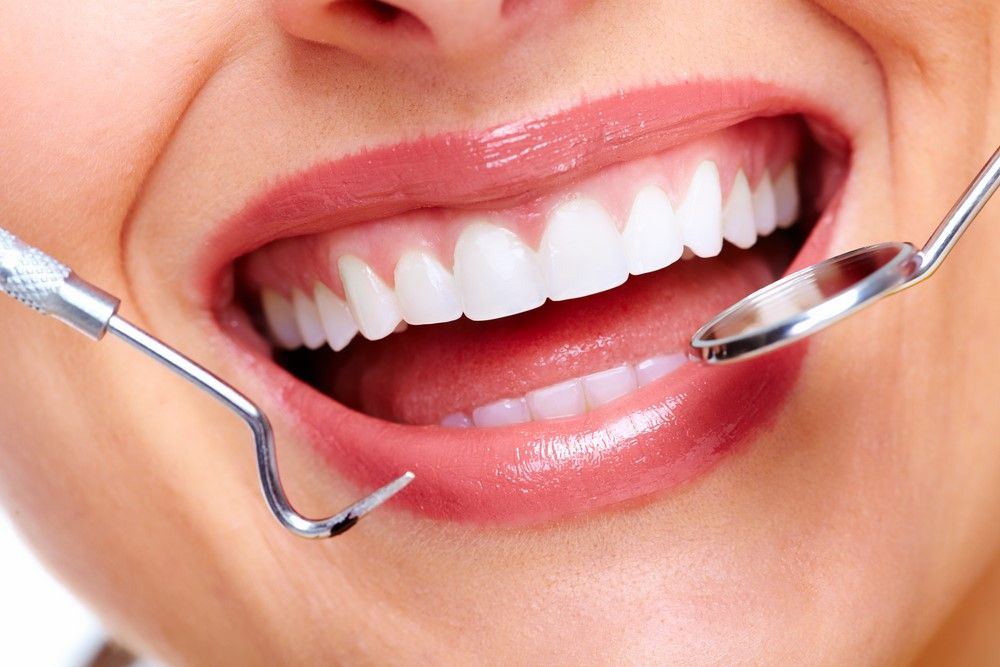
Dental Cleaning and X-Rays
Finding a new dentist can be a complicated process. After researching dentists near you, making sure that they accept your insurance, getting estimates for your exam, and reading all their reviews, we often forget about the entire point of that initial appointment. Your first appointment helps to establish you as a patient for that office and gets you familiar with a new staff and their general procedures. Your new dentist will likely want to complete an initial screening, review your medical history, and conduct an exam, which generally includes cleaning and x-rays.
The Cleaning
The cleaning is often one of the most dreaded parts of a patient’s dental visit. However, by understanding it a little bit better, you may find that there isn’t anything to be concerned about and also realize the importance of getting regular cleanings.
A tooth cleaning is broken down by dental hygienists into six different parts. We’ll discuss each and give a brief description of what they include.
A Physical Exam – Before your hygienist starts to do anything to your teeth, they conduct a physical exam. They use a small mirror to look for any immediate issues. This includes gingivitis, significant plaque buildup, and noticeable tooth loss or damage.
Remove Tartar and Plaque – Your hygienist will then use the small mirror and a scraper tool (scaler) in order to remove some of the loose buildups of tartar and plaque. You’ll generally hear the scraping sound, but this is not an uncomfortable process. The more accumulation that is on your teeth, the longer this process may take.
Gritty Toothpaste Cleaning – In a professional medical setting, a gritty toothpaste is safe to use twice a year. If you try to do the same procedure at home though, you risk damaging the enamel of your teeth. Your hygienist will use a special electrical toothbrush and professional cleaning toothpaste in order to clean and polish your teeth.
Expert Flossing – As your hygienist completes your flossing, they are looking for any spots that may be susceptible to bleeding on the gums and making sure to remove any of the buildups that were left behind from brushing.
Rinse – Now that your teeth have been cleaned and polished and most of the debris has been manually removed, the rinse helps to remove all the fine plaque or buildup that didn’t come out before. The rinse helps to ensure that your mouth is as clean as possible.
Fluoride Treatment – Fluoride treatments help to add a protective layer to your teeth to continue to protect them and keep them cavity-free. Fluoride hardens when it contacts saliva, so you can consume food and drink immediately after your appointment.
X-Rays
The second part of your initial dental appointment will often include X-rays. X-rays use a low level of radiation that helps to capture images of the inside of your teeth.
These images are helpful in determining any problems that aren’t visible to the naked eye. X-rays can aid your dentist in diagnosing cavities, tooth decay or impacted teeth.

Cavities
Cavities! It’s a word that we all dread when we go to the dentist, but understanding a little more about the causes of cavities and how they are treated may help to alleviate some of this fear.
Cavities are caused by the destruction or weakening of your tooth enamel. Tooth enamel is the hard covering over the tooth that helps to protect the underlying bone and interior of the tooth.
Cavities can occur in children, teenagers, and adults, so it’s important to maintain as much of your enamel as possible.
As you consume sugary foods and beverages throughout the day, a sticky residue builds up on the teeth. Plaque, a sticky form of bacteria, is then attracted to the sugars on your teeth. As the
bacteria grows on your teeth, they excrete an acid that can deteriorate the tooth’s enamel, which over time begins to break down. This breakdown is what creates a cavity.
Cavities occur more frequently in children but can become an increasing concern with age as well. As the gums recede, it exposes weaker portions of the teeth that are more susceptible to cavities. This gum recession can also expose the roots of the tooth and any damage to the root may lead to tooth loss.
Cavities also form in older adults around fillings or dental work. This can be because the tooth has lost a large amount of enamel that younger individuals have not, but may also be attributed to the lack of modern dental work. Older dental work typically doesn’t hold well around the edges and exposes the underlying tooth to damage and decay.
Treating Cavities
When the enamel of the tooth becomes too weak, small holes will start to develop in the actual tooth. If this is the case, your dentist will need to fix the problem, most likely with a filling, or else it will become worse.
Fillings are placed when dentists remove all the damaged tooth and other material from the small hole and then fill the hole with a substance to block any future damage to that part of the tooth. Fillings are made with resins or a combination of materials to protect the tooth.
Avoiding Cavities
There are some simple tricks that people can use to avoid or lessen the amount and severity of cavities that they get over the course of their lives.
Brush twice a day with a fluoride toothpaste – Brushing twice a day helps to remove the buildup of sugars and bacteria on your teeth. Toothpaste that contains fluoride helps to maintain the tooth’s natural enamel.
Clean between your teeth every day – The use of floss or an interdental cleaner can help to remove food or sugars that get caught between the teeth and are not removed by brushing.
Ask your dentist about supplemental fluoride – Many municipal water supplies are treated with fluoride to help the entire population’s dental health. However, if you don’t live in one of these areas or you have issues with cavities, you should ask your dentist about adding supplemental fluoride to your health plan.

Teeth Whitening
A smile is one of the simplest gestures that we can make, but it can also be one of the biggest. A bright smile is considered a reflection of friendliness, honesty, happiness, and health.
An attractive smile can be beneficial in social situations, help attract a partner and also make you more confident and outgoing. We are bombarded with pictures of celebrities flashing mega-watt grins, which unfortunately cause many people to feel self-conscious about their own smile.
The enamel covering the teeth can become stained over time for a number of reasons. The fix for this is teeth whitening, which is considered to be one of the easiest and most economical ways of enhancing the appeal of your smile.
Reasons for tooth discoloration
White teeth are universally considered to be more youthful due to the fact that infant/first teeth are almost always whiter than their adult counterparts.
Adult teeth can become stained or discolored over time due to:
Smoking – one of the biggest contributors to yellowed teeth!
The use of antibiotics as a child/teenager
Exposure to high levels of fluoride
Food or drinks that contain tannins such as oranges,
carrots, red wine, and coffeeTrauma to the tooth
Decay
Damage to nerve or blood vessels inside the root canal
Genetics – the thickness of the enamel covering your teeth is usually determined by genetics. Thinner enamel can often show the color of the dentin beneath it, giving the tooth a darker appearance.
Aging – our teeth naturally darken as we get older
Can’t I just use an over-the-counter teeth whitener?
There are dozens of products on the market that claim to be able to improve the whiteness of your smile without you needing to visit the dentist. However, over the counter products are simply not able to provide the same strength of whitening as professional-grade treatments that your dentist is able to offer. Not only are the results usually only mediocre, but they also fade quicker and usually require more treatments.
We recommend that you at least have the first treatment performed by a dentist who is qualified in providing teeth whitening procedures.
The in-office whitening procedure
Dental whitening is a painless procedure, but one that may require several visits to your dentist in order to achieve the final color results you desire. During your consultation visit, your dentist will likely photograph your teeth to provide a starting point for comparison so that he/she can effectively monitor the progress of your treatment. Your dentist will then perform a thorough examination to ensure that no other treatment is required ahead of the whitening process as well as ask you a number of questions to get to the cause of the discoloration.
Next, your dentist or dental hygienist will give your teeth a thorough cleaning to remove any residue or bacteria that may prevent the whitening process from working properly.
After this, it is time for the whitening to begin.
There are two main types of tooth whitening performed in most offices.

Smile Makeover
Many dental patients are looking for ways to improve the appearance of their teeth and overall look of their smile which is why many dentists have started to offer smile makeover services. These treatment plans are individualized based on a patient’s personal needs.
Smile makeovers can include a variety of treatment options including
Dental veneers
Composite bonding
Tooth implants
Teeth whitening
Patients who are considering any of these options should talk to their dentist about a complete smile makeover. Many dentists can offer overall cost savings when these procedures are grouped into a single treatment plan.
Considerations
When considering a smile makeover, it is important to think about what your desired outcome is as well as recognize the parts of your smile that you already appreciate in order to best come up with a treatment plan with your dentist.
Your dentist will consider a variety of aspects when developing your treatment plan. Some of the things that they consider are your natural skin color, face shape, hair color, tooth factors (shape, length, width, and color), and your lip shape and color.
There are several potential issues that your dentist will be able to help with, but it is important to understand what they can do and what their limitations are.
Color – many patients aren’t happy with the whiteness of their teeth. Over time teeth can become stained or discolored. This can be due to dental hygiene, dietary factors, tobacco use, or enamel thickness. Your dentist has a variety of options at their disposal in order to brighten your teeth to a brighter shade of white.
Alignment or Spacing – teeth that are unevenly spaced or crooked are a common issue that many people face. You can work with your dentist to identify options to straighten your teeth and correct their spacing. Two options that are frequently used are Invisalign and orthodontics.
Missing Teeth – Many patients feel self-conscious due to missing teeth, which can occur because of a variety of reasons. Your dentist will be able to replace missing teeth with dental implants, bridges, or partial dentures.
Balance and Overall Aesthetics – When patients have cracked or uneven teeth, dental work is an option to help restore and improve the overall appearance of your smile. Dentists even have the ability to help recontour an overly gummy smile.
Fuller Cheeks or Lips – There are some cosmetic surgery options that can help restore your smile to a more youthful appearance including orthodontics or maxillofacial surgeries. You can discuss these options and more with your dentist.
There are also a number of aesthetic components that will weigh into your smile makeover treatment plan:
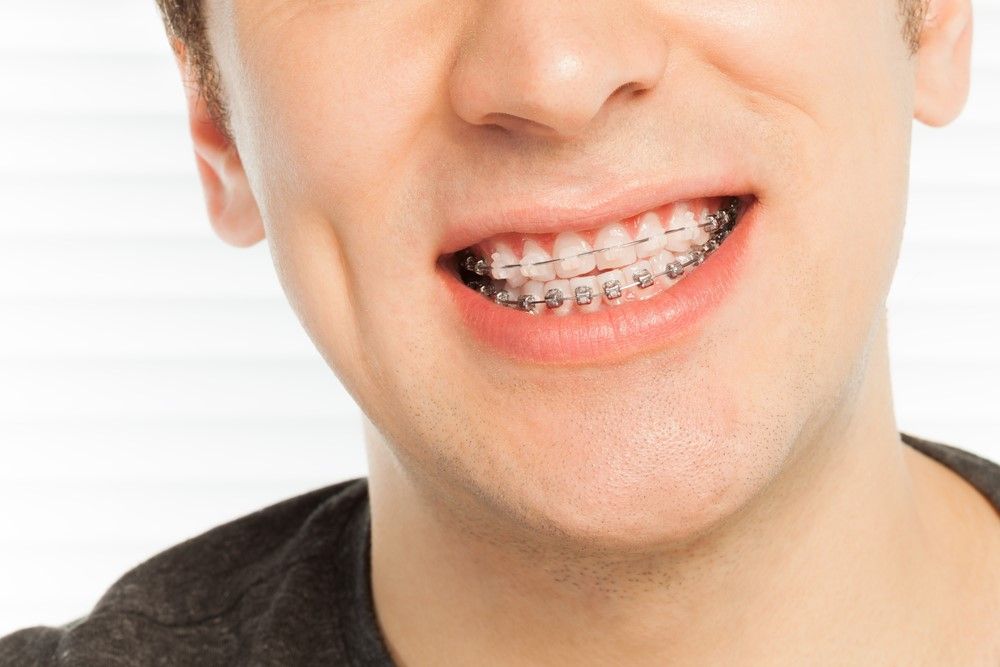
Orthodontics
Orthodontic treatment is a type of dental treatment that addresses teeth and jaws that are incorrectly positioned. Most people have not been blessed with perfectly aligned teeth naturally and as such, the number of referrals for orthodontic treatment is growing every year.
Many people think that correctly positioned teeth are primarily a cosmetic concern. However, crooked teeth and misaligned bites can create a whole variety of health problems including head, shoulder, neck, and jaw pain as well as an increased risk of early tooth decay since crooked teeth are often more difficult to keep clean. These are just some of the reasons that orthodontic treatment is an investment in the future of your oral health, giving you a healthier mouth and a more confident smile.
Problems that can be corrected with orthodontic treatment
Your dentist may recommend you for orthodontic treatment if:
Your teeth do not sufficiently fill your mouth,
leaving you with lots of gaps.You have too many teeth trying to fit onto the dental ridge.
You have an overbite – where the top teeth stick out over the bottom teeth when biting together.
You have an under-bite – where the bottom teeth sit further forward than the top teeth when biting together.
You have an open bite – where there are spaces between the surfaces of your teeth when biting together.
You have a cross-bite – where the upper teeth fail to come down just in front of the lower teeth when biting together.
The centerline of your top teeth fails to fall in line with the center of your bottom teeth.
What types of orthodontic treatment are available?
During your initial consultation with your orthodontic specialist, you will discuss which type, or types, of orthodontic treatment is right for you based on your specific needs.

Laser Dentistry
Laser therapy is a relatively new innovation that is currently being used across a number of medical and cosmetic surgery fields including optometry, dermatology, pain management, and beauty therapy. Although laser therapy has been used in dentistry since 1994, it is only more recently that this innovative approach to dental treatment has really gained momentum.
Despite being approved by the FDA, there hasn't been any laser system that has received the American Dental Association’s (ADA’s) Seal of Acceptance as an alternative to mainstream treatment. However, many dentists are using laser therapy very successfully to treat a variety of dental issues.
Teeth Whitening
By far the most common dental procedure that uses laser technology is cosmetic teeth whitening. Teeth whitening is the number one cosmetic dental procedure in the U.S. because it is a quick and painless method of correcting discolored teeth that provides patients with a significantly brighter smile.
This can give the wearer increased confidence in personal, professional, and social situations. In fact, many people believe that a great smile can seriously influence your success in life.
One of the biggest benefits of laser teeth whitening is the speed with which you can both have the procedure done and see the results. Typically, you can expect a laser teeth whitening session to be completed in under 90 minutes which makes it easy to fit into most schedules. Better still, the majority of patients find that one treatment is enough to significantly brighten their teeth for a period of time. That said, no whitening treatment lasts forever.
The length of time you can expect your teeth to maintain their whiteness will depend on several factors including your oral healthcare routine, the use of complimentary whitening products such as toothpaste and mouthwash with whitening ingredients, and how willing you are to try and avoid food and drink that are likely to cause stainings, such as coffee and red wine. Many patients who choose laser teeth whitening schedule annual or bi-annual treatments in order to keep up the appearance of their smile.
Laser teeth whitening is considered a cosmetic treatment and as such, very few dental insurance policies will cover this procedure. However, many dentists offer affordable payment plans that may be of assistance to you.
The exact price that you will pay will vary depending on your dentist and the extent of the discoloration of your teeth, but you can expect to pay around $1,000 for the procedure.
Other Laser Dentistry
Laser dentistry can also be a highly effective method of performing many other dental procedures including detecting and filling cavities, dealing with tooth sensitivity, crown lengthening, reshaping gum tissue, and temporomandibular joint treatment.
There are a number of benefits of performing these procedures using laser therapy including:
Procedures performed using soft tissue dental lasers may not require sutures.
Damage to the surrounding tissue is minimal. Some procedures may not even require an anesthetic.
Bleeding is minimized as the laser encourages blood clotting to take place.
Wounds heal faster and tissue can be regenerated quickly. The risk of bacterial infection is also minimized as the laser helps to sterilize the area while it's being worked on.
Laser dental treatments are particularly popular among anxious or nervous patients since it is less invasive than more traditional methods and often much quieter and subtler. If you would like to consider having a dental procedure performed using laser therapy, please contact your dentist who will be happy to advise you further.

3-D Imaging
Patients who have been routinely visiting their dentist are all too familiar with the traditional X-ray imaging that is employed at most dental offices. However, there is a breakthrough technology that offers better imaging and improved patient outcomes.
How it Works
3-D imaging for your teeth uses a technology called CBCT or Cone Beam Computed Tomography. This technology uses targeted beam limitation which can reduce the exposure to radiation employed by typical X-ray imaging. It has improved accuracy and image quality over traditional images as well as better bone quality assessment. All of these factors help lead to a more complete picture for your dentist to base your treatment upon.
Main Advantages of 3-D Imaging
Utilizing this new technology results in several overall benefits for the patient and their care provider.
Ability to create hundreds of images from a single scan
Control over the quality of the image
Technology passes easily through the lips and gums.
The overall reduction in radiation exposure
Ability to zoom in on small areas on a single tooth or group of teeth.
How Technology is Used
Using 3-D imaging has been an overall improvement in several areas of dentistry, but is utilized in some areas more than others.
Cosmetic/Restorative Work – This type of work includes crowns, veneers, inlays and onlays, bone grafts, root canals, and implants. 3-D technology can improve this process by helping to prepare the patient and care provider for more advanced treatments. The dentist is then more capable of planning for these procedures with a better idea of any difficulties that they may encounter.
Orthodontic – 3-D imaging creates an overall image that helps to address any concerns ahead of treatment and can monitor overall progress.
Implants – This imaging is so accurate that it can help determine the correct location for the placement of dental implants as well as reduce the number of fittings to a single appointment.
The Future of Care
The benefits of 3-D imaging are quickly becoming apparent to dental offices everywhere. Many dentists can see the advantages of purchasing the machinery and are making sure that their patients have the highest level of care. If you are looking for the best imaging and care, ask your dentist today if they have the capabilities for 3-D imaging. If they don’t, ask them if they expect to be gaining that ability in the future and discuss the benefits for your care.
3-D imaging allows you and your dentist to see your dental health in a way that you never thought possible. This approach enables your dentist to better view your teeth and skull as well as identify any










